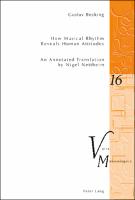How Musical Rhythm Reveals Human Attitudes
An Annotated Translation by Nigel Nettheim
Abstract
What is the broadest significance of musical rhythm? Human attitudes to the world are reflected in it, according to Gustav Becking. Writing in the 1920s, Becking proposed a novel method of finding systematic differences of attitude between individual composers, between nations, and between historical time periods. He dealt throughout with Western classical music, from the period approximately 1600-1900. His method was to observe in fine detail the pattern of motion and pressure traced out by a small baton allowed to move in sympathy with a given musical excerpt. The various patterns arising for individual composers were represented graphically, and in that form became known as «Becking curves». Implications were touched upon in psychology, sociology and philosophy. His thesis is now published in English translation from the original German for the first time, with many annotations.
Keywords
Aesthetics, Theory of Art, Poetics; Analysis; Annotated; Attitude and Role; Attitudes; History of Musical Periods; History of Styles, Forms and Genres; Human; Krakauer; Musical; Nettheim; Nigel; Peter; Reveals; Rhythm; TranslationISBN
9783034346917, 9783034303088, 9783034346917Publisher website
https://www.peterlang.com/Publication date and place
Bern, 2011Series
Varia Musicologica, 16Classification
Theory of music and musicology
Music reviews and criticism
Music: styles and genres
Philosophy: aesthetics
Behaviourism, Behavioural theory


 Download
Download Web Shop
Web Shop